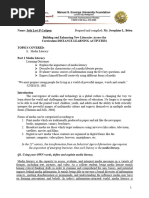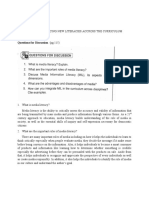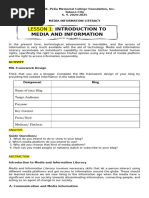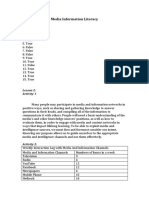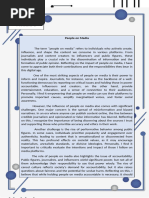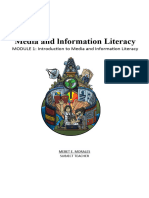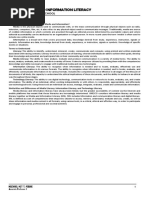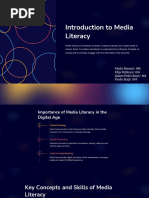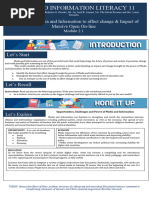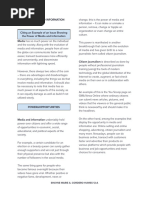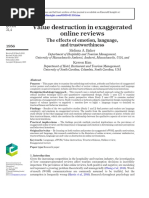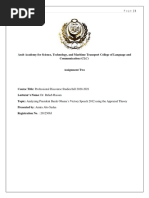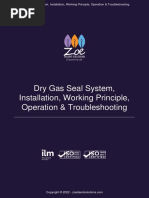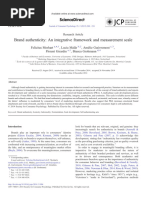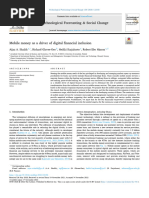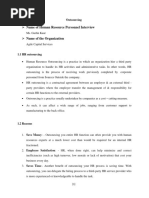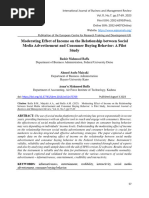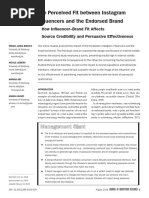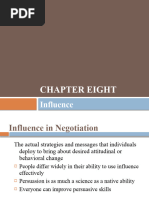0 ratings0% found this document useful (0 votes)
11 viewsMil Reviewer
Mil Reviewer
Uploaded by
SOLACE CORTEZg12
Copyright:
© All Rights Reserved
Available Formats
Download as DOCX, PDF, TXT or read online from Scribd
Mil Reviewer
Mil Reviewer
Uploaded by
SOLACE CORTEZ0 ratings0% found this document useful (0 votes)
11 views2 pagesg12
Copyright
© © All Rights Reserved
Available Formats
DOCX, PDF, TXT or read online from Scribd
Share this document
Did you find this document useful?
Is this content inappropriate?
g12
Copyright:
© All Rights Reserved
Available Formats
Download as DOCX, PDF, TXT or read online from Scribd
Download as docx, pdf, or txt
0 ratings0% found this document useful (0 votes)
11 views2 pagesMil Reviewer
Mil Reviewer
Uploaded by
SOLACE CORTEZg12
Copyright:
© All Rights Reserved
Available Formats
Download as DOCX, PDF, TXT or read online from Scribd
Download as docx, pdf, or txt
You are on page 1of 2
Media And Information Literacy
REVIEWER
LESSON I. Introduction to Media and Information Literacy
Communication is the directed and purposeful exchange of information and
messages between people or group of people by speaking, writing, gestures, and
signs.
The role of media literacy in today’s society is to help people critically
evaluate media messages.
The most effective communication channel to use in reaching a larger
audience is through PowerPoint Presentations
LESSON II. The Evolution of Traditional Media to New Media
Books are the first widely used mass media in the history
Fact-checking information before sharing it can be used by a responsible digital
citizen to avoid potential misinformation in social media
New media has created new opportunities for individuals to produce and distribute
contents for people to consume information
Individuals can become more critical users of information by analyzing the
techniques used in media to persuade and influence audiences, by questioning
and evaluating media messages critically, by identifying biases and propaganda
in media content, and by cross-checking information for more accurate and
verified content
LESSON III. Information Literacy
The evolution of new media affected the role of journalists through the increased
demand for specialized skills
A peer-reviewed academic journal article is the most reliable source if you are
researching for a school project.
When using archival footage, it is necessary to have ethical considerations such
as obtaining permission from the owners of the footages.
LESSON IV. Types of Media
The main advantage of traditional media compared to digital media is it is more
accessible to older generations.
Convergence media or media convergence is the term we use for media that
combines elements of print, broadcast and other types of media
Digital media is most suitable type of media to be used for information you want to
share with the whole world.
Traditional media is less likely to be affected by technological advancements, while
new media is more susceptible to change.
In terms of the influence of the social media to the interpersonal relationship of
people, we can say that the social media has both strengthened and weakened
interpersonal relationships, depending on how it is used.
LESSON V. Media and Information Sources
The most popular search engine in the world is the www.google.com
Reliability is the term we use to describe the credibility and the trustworthiness of a
source
When comparing “fake news” and “misinformation”, it is better to say that
“Fake news is intentionally false created to deceive, while misinformation is
simply incorrect information.”
A medical journal article is the best type of source you would need if you wanted to
know about a specific medical condition
The information is said to be valued if it aids the user in making or improving
decisions. The authority and credibility of the source is based on the one who
authored or published the information.
The ability to communicate almost instantly is one of the best features of the
internet. Through Internet technology, you can pay your bills, manage bank
accounts, meet new people, or learn new skills.
Critically evaluate the study's methodology and limitations when researching
about studies with positive correlation but has been criticized for its lack of control
of the other factors.
LESSON VI. Media and Information Languages
Media language is the term we used for the languages used in Media and Information
Literacy
Colors in visual media can influence the audience’s emotional response because
it can evoke specific feelings and associated with emotions.
Genre conventions create predictable patterns that allow audiences to engage
with familiar elements.
By understanding how different media languages can influence audience
perceptions and emotions, advertisers can create more targeted and
persuasive campaigns.
The use of a red filter to create a sense of danger is an example of symbolic code in a
film
Sound can affect the audience’s interpretation of media text by creating a mood,
disposition, or atmosphere
The primary purpose of slogan and tagline in an advertisement is to create a
memorable and catchy phrase
In creating a social media campaign to promote a new product, you can use
language to evoke a sense of nostalgia and connect with your target audience by
referencing popular culture from the
past
LESSON VII. Legal, Ethical, and Societal Issues in Media and Information
Copyright is the term for legal right to own and control intellectual property, such as,
books, music, software and other literary works.
Ethical implications of “Plagiarism” are: It can harm the reputation of the original
creator, It can be considered academic dishonesty, It can mislead and undermine the
value of original work, and It can discourage original creativity & innovation.
Artificial intelligence can lead to job placement and economic equality is
NOT an ethical consideration in the use of Artificial Intelligence.
Fair use allows limited use of copyrighted material without permission for
purposes such as parody, news reporting, education, and research.
The difference of Cyberbullying among other type of bullying is that it is more
anonymous and can reach a wider audience
LESSON VIII. Opportunities, Challenges, and Power of Media and Information
The ability of media to influence public opinion and behavior is called “medial
influence”.
Media literacy helps individuals to search for information and make them
powerful is not a significant factor in empowering individuals
Individuals can use media in protecting their privacy and security online by being
aware of the risks of online scams and phishing attacks.
Enhanced global connectivity is one of the major opportunities presented by the
various social media platforms
You might also like
- Benlac U3 L12-13Document45 pagesBenlac U3 L12-13Van Errl Nicolai SantosNo ratings yet
- Final Reflection Spectrum Sunglass PDFDocument11 pagesFinal Reflection Spectrum Sunglass PDFRio Sam100% (1)
- Effective Report Writing SkillsDocument69 pagesEffective Report Writing SkillsAung Pyae'Zone100% (3)
- Building and Enhancing New Literacies Across The CurriculumDocument2 pagesBuilding and Enhancing New Literacies Across The CurriculumAdora ortego100% (1)
- Module 1 Introduction To Media and Information LiteracyDocument12 pagesModule 1 Introduction To Media and Information LiteracyJohn Brylle GuangcoNo ratings yet
- CONCEPT-NOTES-2ND-QUARTER-MILDocument6 pagesCONCEPT-NOTES-2ND-QUARTER-MILdeilliam03No ratings yet
- MilDocument29 pagesMilJanice BotillaNo ratings yet
- EDUC 109 - Activity 1Document3 pagesEDUC 109 - Activity 1hannahmae surbicoNo ratings yet
- LESSON1 And2 Midterm AsynchDocument9 pagesLESSON1 And2 Midterm AsynchJath LeviNo ratings yet
- Media Literacy: ObjectivesDocument8 pagesMedia Literacy: Objectivesangeli camille100% (1)
- Module 5 Media Literacy PDFDocument18 pagesModule 5 Media Literacy PDFSheena Glen ValdenibroNo ratings yet
- Book Review / Mod 7 8Document10 pagesBook Review / Mod 7 8HentaiYoshiii YTNo ratings yet
- Educ 2. Module #11. Uraga. BSED 1-1Document5 pagesEduc 2. Module #11. Uraga. BSED 1-1Jeshley UragaNo ratings yet
- Media LiteracyDocument18 pagesMedia LiteracyShy PaguiganNo ratings yet
- Activity 1 PrefinalDocument5 pagesActivity 1 PrefinalLynnah SibongaNo ratings yet
- L1: Introduction To Media and Information LiteracyDocument25 pagesL1: Introduction To Media and Information LiteracyEllyNo ratings yet
- E-Learning Guide On Media and Information LiteracyDocument9 pagesE-Learning Guide On Media and Information LiteracyKenneth L. MaqueNo ratings yet
- EDUC 328 Module 07 TaskDocument2 pagesEDUC 328 Module 07 TaskKim MierNo ratings yet
- Lesson 1 Com112 Media and Information LiteracyDocument4 pagesLesson 1 Com112 Media and Information LiteracymohammadbenanshaNo ratings yet
- Book Review /D 3 4Document8 pagesBook Review /D 3 4HentaiYoshiii YTNo ratings yet
- Media and Information LiteracyDocument32 pagesMedia and Information LiteracyMyke RullanNo ratings yet
- Lesson 1 Introduction To MilDocument20 pagesLesson 1 Introduction To Milmaricar reyesNo ratings yet
- Week 1 Introduction To Media and Information LiteracyDocument2 pagesWeek 1 Introduction To Media and Information LiteracyRainNo ratings yet
- News ReportDocument1 pageNews ReportTin FaurNo ratings yet
- MEDIA LITERACY - MCDocument14 pagesMEDIA LITERACY - MCMrinal ChatterjeeNo ratings yet
- MIL-L1Document4 pagesMIL-L1carlnathan0620No ratings yet
- Media LiteracyDocument29 pagesMedia LiteracyAbubakar shomarNo ratings yet
- MIL. ReportDocument7 pagesMIL. ReportElliakim JavierNo ratings yet
- Media LiteracyDocument41 pagesMedia LiteracyApril Bagon-FaeldanNo ratings yet
- Media LiteracyDocument7 pagesMedia LiteracyJO NANo ratings yet
- 4 Pics 1 WordDocument7 pages4 Pics 1 WordlemiNo ratings yet
- Reviewer FOR MEDIADocument4 pagesReviewer FOR MEDIAClaes TrinioNo ratings yet
- Media Information LiteracyDocument5 pagesMedia Information LiteracyLexter PlacienteNo ratings yet
- Handout 01-Q1 Introduction To Media and Information LiteracyDocument3 pagesHandout 01-Q1 Introduction To Media and Information LiteracyMel FayieNo ratings yet
- Media and Information LiteracyDocument105 pagesMedia and Information LiteracyJayMoralesNo ratings yet
- CLIFFORD- MILDocument6 pagesCLIFFORD- MILkayeshie7No ratings yet
- Module 7Document31 pagesModule 7AllingNo ratings yet
- GROUP 3medialiteracy Written ReportDocument8 pagesGROUP 3medialiteracy Written ReportJayson PasiaNo ratings yet
- Definition of PollingDocument10 pagesDefinition of Pollingmoshood AbdulwaheedNo ratings yet
- WEEK 1 Communication Media and InformationDocument39 pagesWEEK 1 Communication Media and InformationIan ManansalaNo ratings yet
- Epoy FinalDocument6 pagesEpoy Finalkayeshie7No ratings yet
- Lesson 2 Media Infiormation Technology LiteracyDocument49 pagesLesson 2 Media Infiormation Technology Literacyice vizcarra100% (1)
- MIL Module 1 2 - REVIEWERDocument3 pagesMIL Module 1 2 - REVIEWERAtria Mariz Ricamonte OrbistaNo ratings yet
- MIL WK 1Document16 pagesMIL WK 1Mebet MoralesNo ratings yet
- Information Sheet No. 3Document1 pageInformation Sheet No. 3Vin Draude G. TamangNo ratings yet
- Ponciano, Ganilyn D. - STEM 12-A (MIL 3)Document5 pagesPonciano, Ganilyn D. - STEM 12-A (MIL 3)Ganilyn PoncianoNo ratings yet
- Media Info. Literacy Lesson 2Document29 pagesMedia Info. Literacy Lesson 2Angielyn Meirew AneroNo ratings yet
- Mil Hehehe - 020936Document22 pagesMil Hehehe - 020936Roxanne PabicoNo ratings yet
- Media LiteracyDocument8 pagesMedia LiteracyPavle StajićNo ratings yet
- MIL Week1Document36 pagesMIL Week1Andie PanaliganNo ratings yet
- Opportunities HuhuDocument44 pagesOpportunities HuhuYve LuelleNo ratings yet
- Introduction To Media Information LiteracyDocument41 pagesIntroduction To Media Information LiteracySeth Gabriel BucoyNo ratings yet
- Media LiteracyDocument24 pagesMedia LiteracyAnna Cristina AmangcaNo ratings yet
- What Is Media LiteracyDocument2 pagesWhat Is Media LiteracyJohn Paul MartinNo ratings yet
- Mil 2.1Document4 pagesMil 2.1Coleen Marie RosellNo ratings yet
- Potter 2004Document7 pagesPotter 2004P.Y.NNo ratings yet
- 1st Summa NotesDocument3 pages1st Summa Notespintoatulan18No ratings yet
- I Objective: Media LiteracyDocument14 pagesI Objective: Media LiteracyRose Marie Balmores100% (1)
- 4th QRT MILDocument18 pages4th QRT MILfebe.ledesmaNo ratings yet
- LP Introduction To MILDocument4 pagesLP Introduction To MILdiana cruzNo ratings yet
- Media PsychologyDocument4 pagesMedia Psychologysanskriti gautamNo ratings yet
- Navigating The Digital Landscape The Importance of Media LiteracyDocument2 pagesNavigating The Digital Landscape The Importance of Media LiteracyAlexie AlmohallasNo ratings yet
- Digital Media Reach: A Comparative Study of Rural and Urban People in IndiaDocument10 pagesDigital Media Reach: A Comparative Study of Rural and Urban People in IndiaSmita DikshitNo ratings yet
- A Critical Analysis of John P. Kotter's Change Management FrameworkDocument24 pagesA Critical Analysis of John P. Kotter's Change Management FrameworkAobakwe N. KeaitseNo ratings yet
- Literature Review Format Political ScienceDocument8 pagesLiterature Review Format Political Sciencec5e83cmh100% (1)
- Final MT Report - Juhi SinghDocument62 pagesFinal MT Report - Juhi SinghJuhi singhNo ratings yet
- Final Capstone Draft ProposalDocument7 pagesFinal Capstone Draft Proposalapi-549040950No ratings yet
- Swarup CT Ast - 3Document2 pagesSwarup CT Ast - 3agrawalronak432No ratings yet
- Value Destruction in Exaggerated Online Reviews: The Effects of Emotion, Language, and TrustworthinessDocument21 pagesValue Destruction in Exaggerated Online Reviews: The Effects of Emotion, Language, and TrustworthinessYa YaNo ratings yet
- President Barack Obama's Victory Speech 2012Document5 pagesPresident Barack Obama's Victory Speech 2012AmIra Abo Se'daNo ratings yet
- Communication For Various Purposes.Document17 pagesCommunication For Various Purposes.Mica Erica Cabais100% (1)
- Dry Gas Seal System, Installation, Working Principle, Operation & TroubleshootingDocument9 pagesDry Gas Seal System, Installation, Working Principle, Operation & Troubleshootingrizwan javedNo ratings yet
- ARTICLEDocument14 pagesARTICLEarsyNo ratings yet
- Module 1Document17 pagesModule 1Akshitha KulalNo ratings yet
- 5 Primary Source of Information Including Its Credibility, Authenticity, and ProvenanceDocument7 pages5 Primary Source of Information Including Its Credibility, Authenticity, and ProvenanceRoyarlyn CañelasNo ratings yet
- Building Customer Brand Relationships On PDFDocument28 pagesBuilding Customer Brand Relationships On PDFantoni ludfi arifinNo ratings yet
- Brand Authenticity: An Integrative Framework and Measurement ScaleDocument3 pagesBrand Authenticity: An Integrative Framework and Measurement ScalemoeNo ratings yet
- Mobile Money As A Driver of Digital Financial InclusionDocument14 pagesMobile Money As A Driver of Digital Financial InclusionSabrine BelgaiedNo ratings yet
- Human Resource LabDocument28 pagesHuman Resource LabParampreet SinghNo ratings yet
- Facebook Credibility Evidence From Onlineand Offline Political Participation Politicalcontribution and Platform EfficacyDocument11 pagesFacebook Credibility Evidence From Onlineand Offline Political Participation Politicalcontribution and Platform EfficacyFayeed Ali RassulNo ratings yet
- Moderating EffectDocument13 pagesModerating EffectAubin DiffoNo ratings yet
- The New CIO: How To Make An Impact The First Year On The JobDocument14 pagesThe New CIO: How To Make An Impact The First Year On The JobVV100% (1)
- Workplace Writing - A Handbook For Common Workplace Genres and ProDocument120 pagesWorkplace Writing - A Handbook For Common Workplace Genres and ProVelaniNo ratings yet
- JAR 2019 030.fullDocument15 pagesJAR 2019 030.fullNhư NhiênNo ratings yet
- En9Lc-Ivh-2.15: Evaluating BooksDocument3 pagesEn9Lc-Ivh-2.15: Evaluating BooksNIMFA SEPARANo ratings yet
- Unit 1+2+3 - HondaDocument14 pagesUnit 1+2+3 - HondaDu Từ TrungNo ratings yet
- 2020 Specimen Paper 2Document6 pages2020 Specimen Paper 2kheyNo ratings yet
- Chapter 8Document16 pagesChapter 8katie.tarakachadNo ratings yet
- Project Space Final Essay 9 25 2Document7 pagesProject Space Final Essay 9 25 2api-535000695No ratings yet








